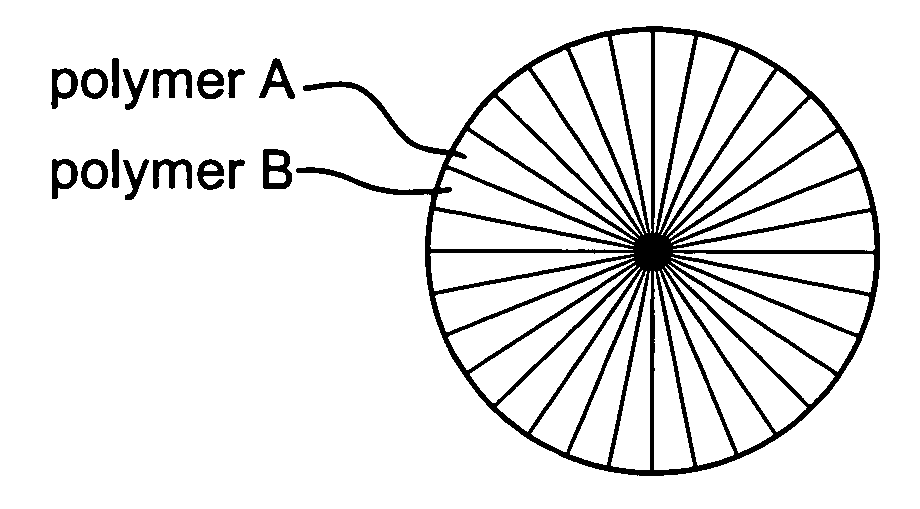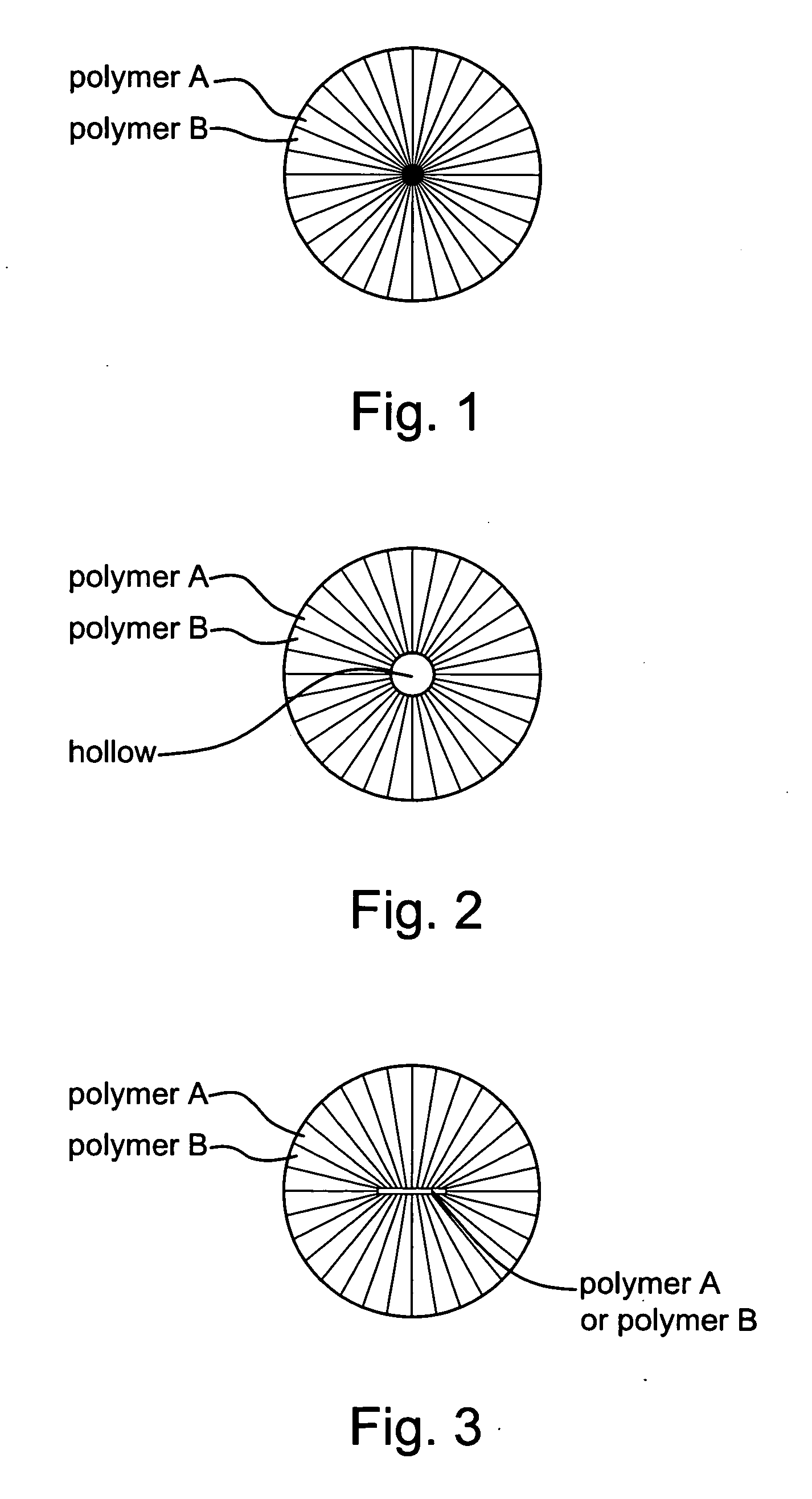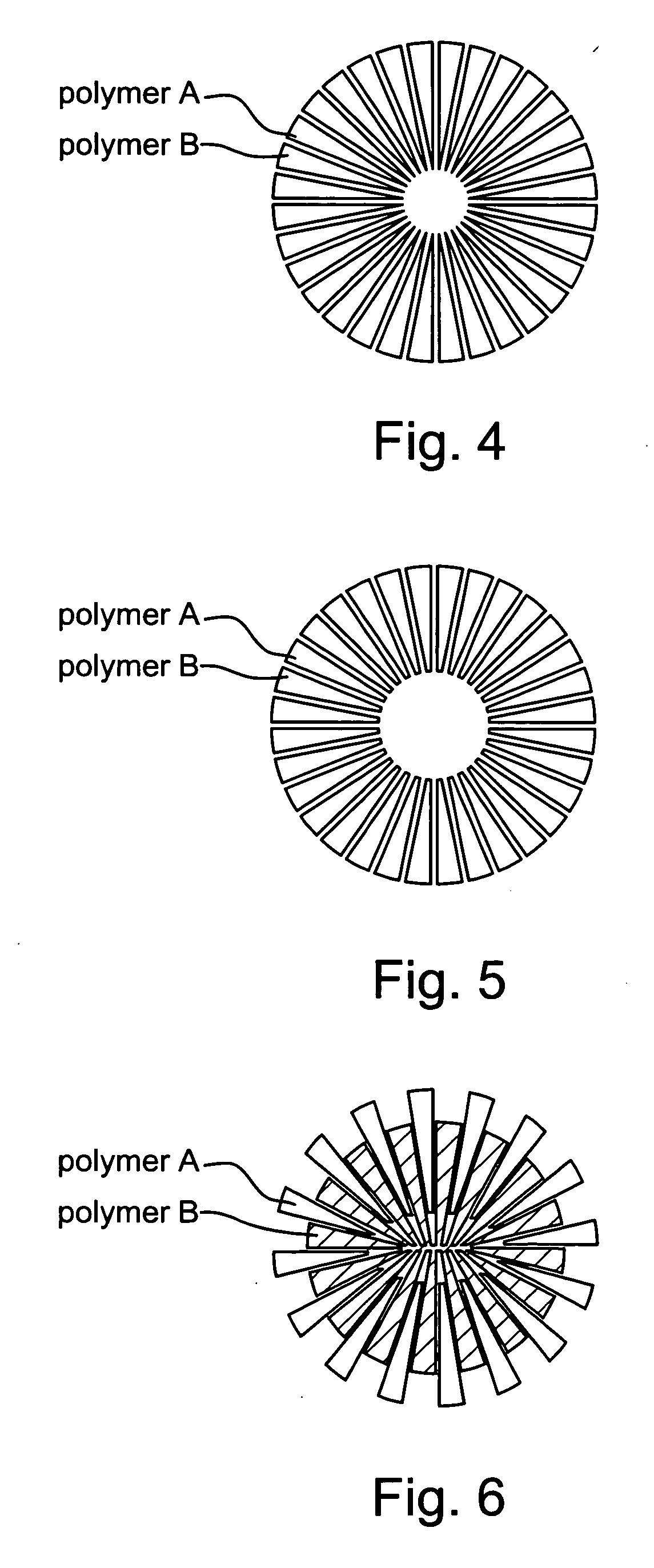Substrate of artificial leather including ultrafine fibers and methods for making the same
a technology of artificial leather and ultrafine fibers, applied in the field of methods, to achieve the effect of excellent softness and drap
- Summary
- Abstract
- Description
- Claims
- Application Information
AI Technical Summary
Benefits of technology
Problems solved by technology
Method used
Image
Examples
first embodiment
[0052] According to the present invention, PET (IV=0.64) made by Far Eastern Textile Ltd. and NY6 (RV=2.4) made by BASF are conjugate spun at a ratio of 55:45. The spinneret includes 32 sectors. The spinning is conducted at a temperature of 295 degrees Celsius. The reeling is conducted at a rate of 850 m / min. There are made un-drawn yarns with a fineness of 8 den, an elongation of 450% and tensile strength of 1.7 g / den. The un-drawn yarns are drawn by a rate of 200%. Drawn rollers are operated at a temperature of 50 degrees Celsius. The yarns are dried at a temperature of 60 degrees Celsius. Finally, the yarns are cut into fibers with a fineness of 4.5 den, an elongation of 80%, tensile strength of 3.3 g / den and a length of 51 mm referring to FIG. 4.
[0053] The fibers are opening, carding, cross-lapping and needle punch so that a non-woven fabric is made with a width of 153 cm, a unit weight of 250 g / m2 and a thickness of 1.8 mm. The non-woven fabric is submerged in water for 3 minut...
second embodiment
[0054] According to the present invention, PBT (IV=0.94) made by Chang Chun Petrochemical Co., Ltd. and NY6 (RV=2.7) made by BASF are conjugate spun at a ratio of 50:50. The spinneret includes 32 sectors. The spinning is conducted at a temperature of 280 degrees Celsius. The reeling is conducted at a rate of 1350 m / min. There are made un-drawn yarns with a fineness of 10 den, an elongation of 550% and tensile strength of 1.5 g / den. The un-drawn yarns are drawn by a rate of 300%. Drawn rollers are operated at a temperature of 70 degrees Celsius. The yarns are dried at a temperature of 70 degrees Celsius. Finally, the yarns are cut into fibers with a fineness of 4.5 den, an elongation of 80%, tensile strength of 3.5 g / den and a length of 51 mm.
[0055] The fibers are opening, carding, cross-lapping and needle punch so that a non-woven fabric is made with a width of 153 cm, a unit weight of 280 g / m2 and a thickness of 2.2 mm. The non-woven fabric is submerged in water for 2 minutes and t...
third embodiment
[0056] According to the present invention, PBT (IV=0.94) made by Chang Chun Petrochemical Co., Ltd. and CO-PET (including SIPE at a molecular percentage of 2.5%) made by Shinkong Synthetic Fibers Corp. are mixed at a ratio of 70:30. The mixture and NY6 (RV=2.4) made by BASF are conjugate spun at a ratio of 50:50. The spinneret includes 32 sectors. The spinning is conducted at a temperature of 282 degrees Celsius. The reeling is conducted at a rate of 1350 m / min. There are made un-drawn yarns with a fineness of 12 den, an elongation of 300% and tensile strength of 1.5 g / den. The un-drawn yarns are drawn by a rate of 300%. Drawn rollers are operated at a temperature of 70 degrees Celsius. The yarns are dried at a temperature of 70 degrees Celsius. Finally, the yarns are cut into fibers with a fineness of 4.5 den, an elongation of 80%, tensile strength of 3.5 g / den and a length of 51 mm.
[0057] The fibers are opening, carding, cross-lapping and needle punch so that a non-woven fabric is...
PUM
| Property | Measurement | Unit |
|---|---|---|
| Temperature | aaaaa | aaaaa |
| Fraction | aaaaa | aaaaa |
| Fraction | aaaaa | aaaaa |
Abstract
Description
Claims
Application Information
 Login to View More
Login to View More - R&D
- Intellectual Property
- Life Sciences
- Materials
- Tech Scout
- Unparalleled Data Quality
- Higher Quality Content
- 60% Fewer Hallucinations
Browse by: Latest US Patents, China's latest patents, Technical Efficacy Thesaurus, Application Domain, Technology Topic, Popular Technical Reports.
© 2025 PatSnap. All rights reserved.Legal|Privacy policy|Modern Slavery Act Transparency Statement|Sitemap|About US| Contact US: help@patsnap.com



